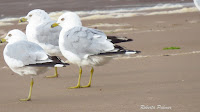RING-BILLED GULL
RING-BILLED GULL (Larus delawarensis) – (See images below)
DESCRIPTION: The Ring-billed Gull is a medium-sized gull with a white body and grey wings. The yellow bill has a black ring midway around it, which gives the bird its name. The legs are yellow, as well as the eyes, which have a red circle. The wings have black tips, as well as the tail. Juveniles have mostly a mottled brown plumage and take three years to reach the plumage of the adult. Sexes are similar. Ring-billed gulls are approximately 18 inches (47 cm) long.
VOICE: https://www.xeno-canto.org/species/Larus-delawarensis
NAME: The English name ‘Gull’ would have its origins in Old Celtic ‘Gullan’ and other languages, including Latin ‘gula’ for throat. As per Choate this would be related to the gull’s ‘indiscriminate’ scavenging habits, its ‘willingness to swallow almost anything’ (think ‘gullible’). The Latin genus name ‘Larus’ refers to a large seabird, and the Latin species name ‘delawarensis’ stems from the fact that the first individuals were identified along the Delaware River.
HABITAT: Along the coasts and bays, also inland at parking lots, fields and garbage dumps.
DIET: Omnivorous – insects, small fish and rodents, crustaceans, garbage.
NESTING: The ring-billed gull nests in colonies generally on small islands. The colonies are not homogeneous, but mixed with other gull species. The nest is a scrape on the ground. Around three eggs are laid, incubated by both parents, who share the feeding of the chicks as well.
DISTRIBUTION: The breeding range of the ring-billed gull covers the southern part of Canada except most of Quebec and western British Columbia, and the northern part of the USA. It migrates south of its breeding range down to Mexico and the Caribbean. Visitor to Hawaii.
Distribution map: https://en.wikipedia.org/wiki/Ring-billed_gull#/media/File:Larus_delawarensis_map.svg
ON PEI: The ring-billed gull breeds on Prince Edward Island, and its presence is very common except in the winter, where it is rare.
GULLS ON HAWAII: Gulls are not long time residents or indigenous to Hawaii. They are continental species and the Hawaiian Islands don’t seem to provide them with the habitat they need. Those birds that do make it however have either flown on their own or got blown off course, or hitched a ride on ships. In either case they don’t stay for long.
CONSERVATION: Once hunted for its feathers but now protected, ring-billed gull populations have increased to the point where in some areas it is considered as a pest on farms or airports for example. It has well adapted to human environments and modified its diet to include garbage. It is no longer considered at risk.
SIMILAR SPECIES: American Herring Gull
REFERENCES: http://www.birdweb.org/birdweb/bird/ring-billed_gull
https://en.wikipedia.org/wiki/Ring-billed_gull
http://hww.ca/en/wildlife/birds/ring-billed-gull.html
https://www.audubon.org/field-guide/bird/ring-billed-gull
https://www.mba-aom.ca/jsp/toc.jsp
http://www.nhptv.org/natureworks/ringgull.htm (New Hampshire PBS)
This video below shows ring-billed gulls with Mallards (and one cawing American crow) on an icy river in the winter, Prince Edward Island:
DESCRIPTION: The Ring-billed Gull is a medium-sized gull with a white body and grey wings. The yellow bill has a black ring midway around it, which gives the bird its name. The legs are yellow, as well as the eyes, which have a red circle. The wings have black tips, as well as the tail. Juveniles have mostly a mottled brown plumage and take three years to reach the plumage of the adult. Sexes are similar. Ring-billed gulls are approximately 18 inches (47 cm) long.
VOICE: https://www.xeno-canto.org/species/Larus-delawarensis
NAME: The English name ‘Gull’ would have its origins in Old Celtic ‘Gullan’ and other languages, including Latin ‘gula’ for throat. As per Choate this would be related to the gull’s ‘indiscriminate’ scavenging habits, its ‘willingness to swallow almost anything’ (think ‘gullible’). The Latin genus name ‘Larus’ refers to a large seabird, and the Latin species name ‘delawarensis’ stems from the fact that the first individuals were identified along the Delaware River.
HABITAT: Along the coasts and bays, also inland at parking lots, fields and garbage dumps.
DIET: Omnivorous – insects, small fish and rodents, crustaceans, garbage.
NESTING: The ring-billed gull nests in colonies generally on small islands. The colonies are not homogeneous, but mixed with other gull species. The nest is a scrape on the ground. Around three eggs are laid, incubated by both parents, who share the feeding of the chicks as well.
DISTRIBUTION: The breeding range of the ring-billed gull covers the southern part of Canada except most of Quebec and western British Columbia, and the northern part of the USA. It migrates south of its breeding range down to Mexico and the Caribbean. Visitor to Hawaii.
Distribution map: https://en.wikipedia.org/wiki/Ring-billed_gull#/media/File:Larus_delawarensis_map.svg
ON PEI: The ring-billed gull breeds on Prince Edward Island, and its presence is very common except in the winter, where it is rare.
GULLS ON HAWAII: Gulls are not long time residents or indigenous to Hawaii. They are continental species and the Hawaiian Islands don’t seem to provide them with the habitat they need. Those birds that do make it however have either flown on their own or got blown off course, or hitched a ride on ships. In either case they don’t stay for long.
CONSERVATION: Once hunted for its feathers but now protected, ring-billed gull populations have increased to the point where in some areas it is considered as a pest on farms or airports for example. It has well adapted to human environments and modified its diet to include garbage. It is no longer considered at risk.
SIMILAR SPECIES: American Herring Gull
REFERENCES: http://www.birdweb.org/birdweb/bird/ring-billed_gull
https://en.wikipedia.org/wiki/Ring-billed_gull
http://hww.ca/en/wildlife/birds/ring-billed-gull.html
https://www.audubon.org/field-guide/bird/ring-billed-gull
https://www.mba-aom.ca/jsp/toc.jsp
http://www.nhptv.org/natureworks/ringgull.htm (New Hampshire PBS)
 |
| Ring-billed gulls, PEI, Roberta Palmer |
 |
| Ring-billed gull juvenile, Diane Krauss |